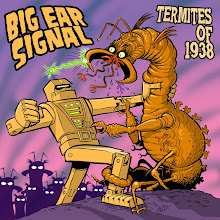Here the neck is being glued into the body. The more clamps the better the joint. I used 3 hand clamps, and a bar clamp to squeeze various spots and directions. I was worried my wife would bump it so I put a watchdog on the case until the glue dried.

After the glue dried I got my chiseled the butt end of the thru-neck to match the shape on the edge of the body. Since it was mostly end grain there wasn't a real good direction to go at it. For the most part I went with the grain, and then went from side to side to smooth out some chisel marks.


I used some sand paper of sequentially finer grits until I'd sanded all the chisel marks out, and has a nice flushed-up joint.


There was a 1/16" gap on the left side of the thru-neck (you can see it in the previous picture.) I put a feather edge (thin wedged strip of mahogany) in that crack and sanded it flush with the face of the guitar. Since it's a wedged strip of wood a feather edge can be driven in until it won't go any further, and it will bow and flex as needed to close up a crack of randomly varying gap sizes. If you look closely at the left side of the neck you can see the feather edge. Once it gets finish it shouldn't be noticeable.


The last thing I did was bore 2 holes for a bridge to be mounted. I double, triple, and quadruplely checked and rechecked my dimension before boring the holes.
I double checked my left-to-right distance too. Back in high school the very 1st musical instrument I ever made was a learning experience of the most painful kind. I didn't get the bridge centered properly in relation to the neck. The strings hatefully and disgustingly hung off the edge of the neck on one side. I believe that guitar was properly disposed of in Pete Townshend fashion.
Every fretboard I get seems to have a different overall scale. If you measure from the nut end of the fretboard down to the 12th fret and double that distance, and that's where the bridge goes. That works no matter what scale the fretboard is. On this particular guitar the distance to the 12th fret was 12 3/4" (a hair more) so the distance from the nut to the bridge was 25 1/2" (a couple hairs more.)
At work when someone says it's "a hair more" we usually have to ask what kind of hair.
Nose hair = 1/64"
Armpit hair = 1/32"
Butt hair = 1/16"
That's industry jargon and most furniture builders know this popular rule of thumb.





Man, is that looking sweet. Damn good thing you got weiner dog on the case. I see he's shrewdly pretending to be napping while in reality he's coiled like a spring, ready to pounce at the first sign of trouble. -- Mykal
ReplyDeleteThis dog's best fight tactic is to fall asleep on the vitim's feet rendering them immobile.
ReplyDeleteLooking good KW.
ReplyDeleteOnce completed, we will hearit, right?
Correct! You will hear something awful no doubt, but you will hear it.
ReplyDeletewow, this is coming along nicely, can't wait to see the finish!
ReplyDelete